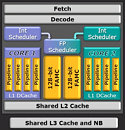Friday, November 6th 2015

AMD Dragged to Court over Core Count on "Bulldozer"
This had to happen eventually. AMD has been dragged to court over misrepresentation of its CPU core count in its "Bulldozer" architecture. Tony Dickey, representing himself in the U.S. District Court for the Northern District of California, accused AMD of falsely advertising the core count in its latest CPUs, and contended that because of they way they're physically structured, AMD's 8-core "Bulldozer" chips really only have four cores.
The lawsuit alleges that Bulldozer processors were designed by stripping away components from two cores and combining what was left to make a single "module." In doing so, however, the cores no longer work independently. Due to this, AMD Bulldozer cannot perform eight instructions simultaneously and independently as claimed, or the way a true 8-core CPU would. Dickey is suing for damages, including statutory and punitive damages, litigation expenses, pre- and post-judgment interest, as well as other injunctive and declaratory relief as is deemed reasonable.
Source:
LegalNewsOnline
The lawsuit alleges that Bulldozer processors were designed by stripping away components from two cores and combining what was left to make a single "module." In doing so, however, the cores no longer work independently. Due to this, AMD Bulldozer cannot perform eight instructions simultaneously and independently as claimed, or the way a true 8-core CPU would. Dickey is suing for damages, including statutory and punitive damages, litigation expenses, pre- and post-judgment interest, as well as other injunctive and declaratory relief as is deemed reasonable.

511 Comments on AMD Dragged to Court over Core Count on "Bulldozer"
AMD should have called:
-core -> integer cluster
-module -> core
...lawsuit never would have happened because the description matches the product.
Once again, you're not addressing the real problem which is the width of the FPU, not the fact that it's shared. When I said re-read my post, I did mean the entire thing, including the second half of it.
Seriously your argument is AMD used an undefined word differently. A module isn't a core, the only thing you can argue is the lack of an FPU per core, but guess what it's still a core at that point.
Edit: I don't want to make this a rant but, as a software engineer, there are a lot of cases where I opt for integers (fixed point,) over floating point values for reasons of performance, accuracy and precision. When you write software that translates something into your earnings or projected earnings, you don't want round-off error or any "lost" data, you want every penny. You want everything to add up to exactly what it's supposed to be, not just for earnings but, so you can confirm your data against an audit if people think you're full of shit. We can't be like Wells Fargo and screw people out of their fractions of a cent like on Office Space because people are scummy. In reality, you need control of that if you're going to be an ethical institution that isn't willing to lie about progress.
I just wanted to get that out there because from my perspective, floating point is a different animal than integer math all together and I treat it completely differently. For that reason, I can't consider the FPU directly part of the core. It's important but, it's a special case to me.
When AMD said "dual core" with FX-62, they didn't mean two integer clusters, they meant two complete processors in one package, each having its own instruction decoder, instruction cache, floating point cluster, integer cluster, and data cache. Intel followed suite with Pentium D. If AMD meant "core" was only the integer cluster, then why did it have two of everything relevant to processing all tasks relevant to x86 (especially instruction decoder and floating point)? That hardware represents standard features in x86 and has been since the 90s.
Logic would suggest having two FPUs per core would be better than two integer clusters per core because of the performance penalties FPUs incur. AMD, instead did the opposite. They took the worst performing part of a processor and shared it with two threads without bolstering it. It was gimped from the day of conception.
"Core" is very well defined and certainly no court would accept your argument that it is "undefined."
"Tony Dickey, representing himself in the U.S. District Court for the Northern District of California, accused AMD of falsely advertising the core count in its latest CPUs, and contended that because of they way they're physically structured, AMD's 8-core "Bulldozer" chips really only have four cores.
The lawsuit alleges that Bulldozer processors were designed by stripping away components from two cores and combining what was left to make a single "module." In doing so, however, the cores no longer work independently. Due to this, AMD Bulldozer cannot perform eight instructions simultaneously and independently as claimed, or the way a true 8-core CPU would."
So he is suing AMD because of this statement. That's all. Personally I don't have CPU design experience so I will not take any side. However, if he wins the process, then he was right, and end of discussion. If not, the same.
Not getting your logic.
If we look only at x86 instruction set with extensions and according market shares today, then truly intel's core is de facto definition what core is :roll: but let's not do that for science sake.
I'm not talking about sales, just processor designs that exist.